Florida, bordered by the Atlantic Ocean on the east and the Gulf of Mexico on the west, is known for its subtropical North and the tropical south. The Sunshine State, as is popularly known, experiences warm temperatures all year round, high humidity, and frequent rainfall.
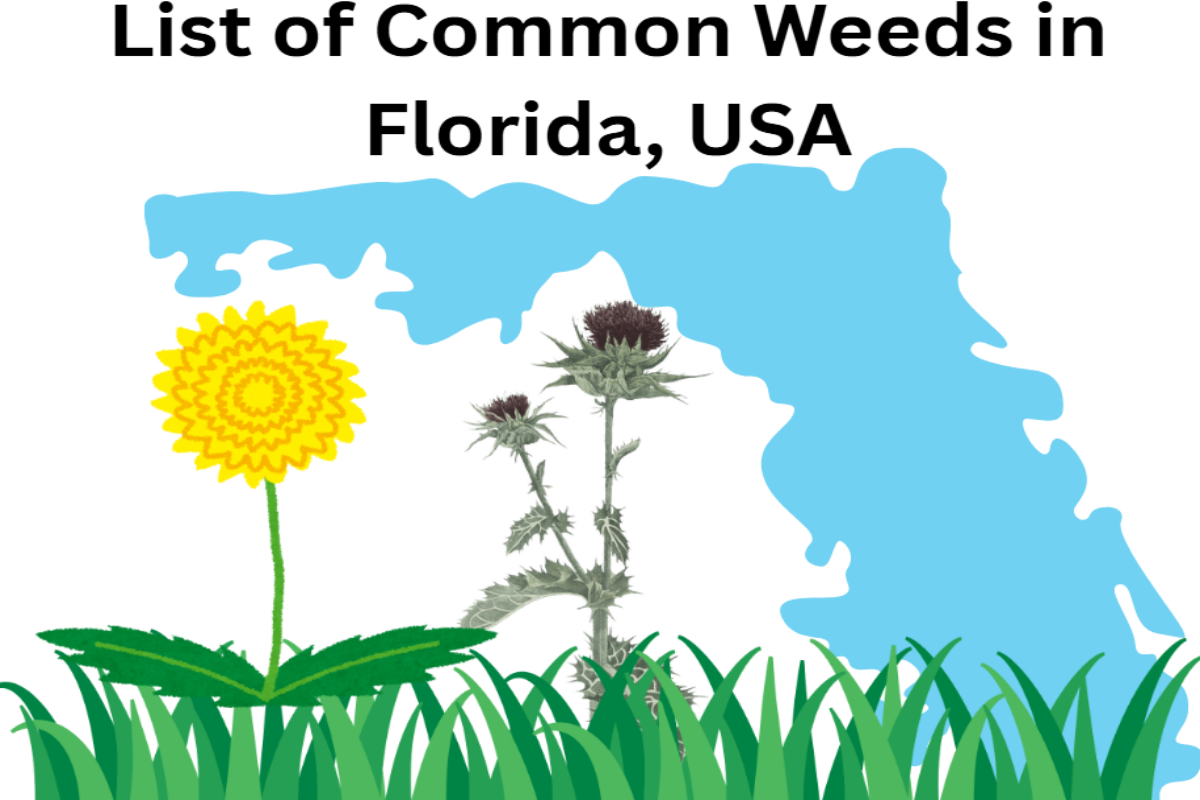
These prolonged and friendly weather conditions allow a varying range of native and invasive weeds to thrive continuously in landscaping, roadsides, fields, pastures, and crop farms.
Below is a list of the most common weeds found in Florida, including details on their physical characteristics for better identification and the best removal methods.
1. Florida Pusley (Richardia scabria)

- Local Name: Florida Snow Weed, Mexican Clover, or Rough Mexican Clover
- Family: Rubiaceae
- Annual or Perennial: Annual
Florida Pusley is a summer annual that’s mostly found in the Southeastern states, prostrate and spreading low along the ground. You can identify the weed by its pubescent, round stems, ovate to lanceolate leaves, and small, white, 6-petaled flowers at the tip ends of the stems.
It spreads by seed but can also regrow from stem fragments, populating habitats such as thinned-out lawns, roadsides, and cultivated fields.
Maintaining a healthy turf discourages weed growth in lawns, while a 2-3 inch layer of organic mulch can control Pusley growth in gardens.
Preemergence herbicides used for Florida Snow Weed control have active ingredients such as pendimethalin, prodiamine, isoxaben, and oryzalin. For existing infestations, consider products containing glyphosate, dicamba, 2,4-D, metsulfuron, and sulfentrazone.
2. Chickweed (Stellaria media)

- Local Name: Common Chickweed, Chickenwort, or Winterweed
- Family: Caryophyllaceae
- Annual or Perennial: Annual
Chickweed is native to Asia, Europe, and Northern Africa. Today, it is widespread globally, including Florida. The winter or cool-annual weed can be found in shady lawns, gardens, pastures, and agricultural fields.
It produces ovate to elliptic leaves, white, star-shaped flowers, and prostrate stems that form dense, compact mats across a landscape.
Frequent pulling, hand-weeding, or hoeing are viable options for small infestations. Be sure to remove the weeds before they bloom. Chickweed is a prolific seed producer and a quick-growing weed.
Applying organic mulch (pine bark, wood chips, or pine straw) can provide effective control in nurseries and landscapes.
If you would like to prevent encroachment, apply preemergent products containing pendimethalin, dithiopyr, prodiamine, or indaziflam. Systemic herbicides like diquat, glufosinate, and glyphosate can help eradicate existing, small or more mature plants, respectively.
3. Carolina False Dandelion (Pyrrhopapus carolinianus)
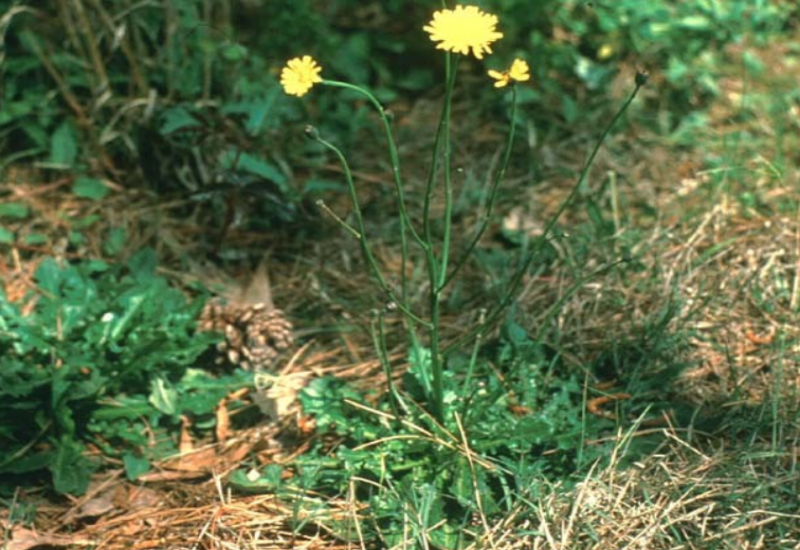
- Local Name: False Dandelion or Carolina Desert Chickory
- Family: Asteraceae
- Annual or Perennial: Annual
Like its close relative, Carolina False Dandelion is easily recognizable by its basal rosette leaves and showy, yellow flowers. However, unlike the typical solitary dandelion, the flower stalk is branched, presenting several flowers.
The weed thrives in wetter areas and can be found mostly in the northern part of the state, and can invade lawns, pastures, roadsides, and open fields.
Maintaining a healthy lawn through proper watering, mowing, and fertilization practices will improve its competitiveness against the dandelion.
4. Southern Crabgrass (Digitaria ciliaris)

- Local Name: Southern Crabgrass
- Family: Poaceae
- Annual or Perennial: Annual
Southern Crabgrass is one of the most notorious grass weeds in Florida. The summer annual invades turfs and agricultural fields in the warmer months, competing for space and other important resources.
Since the grass can’t tolerate cold winter months, it turns brown, creating aesthetic issues in landscaping.
Crabgrass calls for proactive prevention. For cropping systems, dig out the young plants early to prevent establishment.
Ensure that you grow the right type of grass for your area and practice proper maintenance for a thick, healthy lawn that can outcompete weeds.
Additionally, apply preemergence herbicides on already established turf, such as prodiamine, pendimethalin, and dithiopyr, to prevent crabgrass emergence. Postemergence herbicides will most likely harm the weeds and your turf as well.
5. Asiatic Hawksbeard (Youngia japonica)
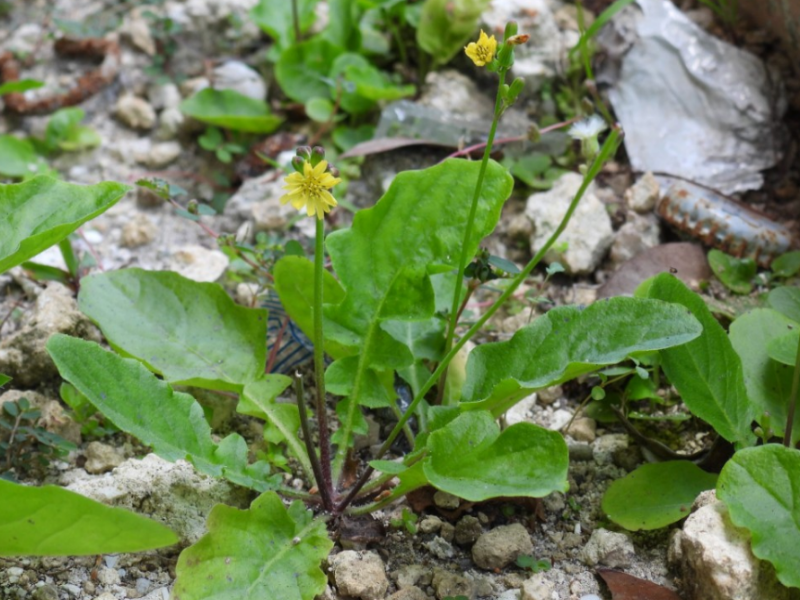
- Local Name: Asiatic False Hawksbeard or Oriental False Hawkbeard
- Family: Asteraceae
- Annual or Perennial: Annual
Asiatic Hawksbeard is a common annual broadleaf weed that grows 6-15 inches tall. It is identified by its hairy, rosette leaves, hairless upper stems, and circular, golden flowers.
While it may be an annual in other Southeastern states, it is a persistent all-year-round weed throughout Florida. The weed can be found in lawns, gardens, ditches, roadsides, and agricultural fields.
Hand-pull the weeds before they develop deep roots or set seed. Laying an organic layer of mulch on garden beds can keep away the weeds.
The preemergence herbicide flumioxazin or spot treatments of postemergence products like pelargonic acid, glyphosate, and diquat can provide effective control against Asiatic Hawksbeard.
6. Dollarweed (Hydrocotyle umbellata)
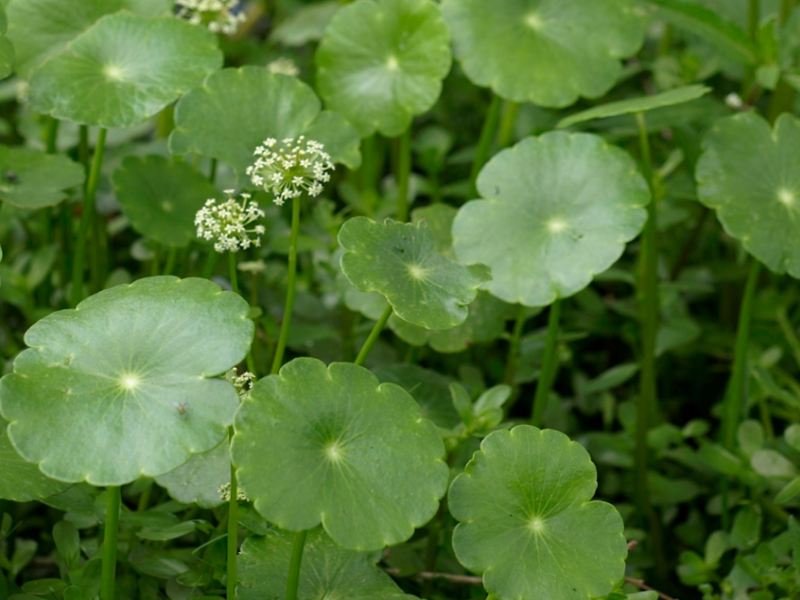
- Local Name: Dollarweed or Pennywort
- Family: Araliaceae
- Annual or Perennial: Perennial
Dollarweed is a native, perennial weed that occurs in wet, open areas. It produces small (the size of a silver dollar, hence the name), round green leaves that form dense mats low on the ground.
Apart from ditches and swamp habitats, Pennywort can also occur in overirrigated or naturally wet areas in gardens and lawns.
Remove the weeds by pulling them, including the white rhizomatous roots, to prevent regrowth. Also, adopt the appropriate mowing and irrigation practices to eliminate weed growth.
7. Carolina Cranesbill (Geranium carolinianum)
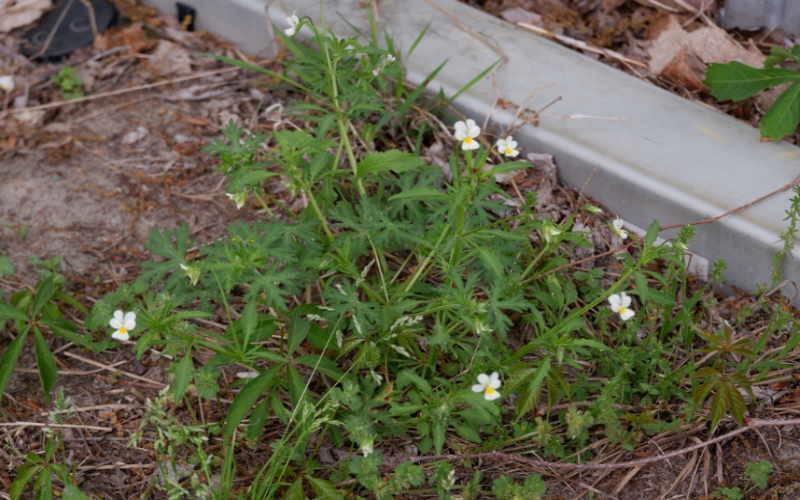
- Local Name: Carolina Geranium or Wild Geranium
- Family: Geraniaceae
- Annual or Perennial: Annual
Carolina Geranium is a native weed commonly associated with landscaping and other disturbed areas. This annual grows from winter to summer and can reach 8-28 inches tall.
You can identify it by its hairy, greenish-pink to red stems, round to kidney-shaped, 5-parted leaves, and five-petaled, pale pink flowers.
While it is a popular garden plant and one of Florida’s favorite pollinators, it is a prolific seed producer and can also become weedy. However, G. carolinianum does not tolerate traffic. So, you’ll find it in border areas, including along fence lines and landscape edges.
To remove Carolina Geranium, maintain a healthy lawn, pull it by hand from its taproot, or cut the plants before seed set. Consider a herbicide like 2,4-D and apply to young actively growing plants.
8. Goosegrass (Eleusine indica)

- Local Name: Goosegrass
- Family: Poaceae
- Annual or Perennial: Short-lived Perennial
Goosegrass is native to Africa, Europe, and Asia. While it is classified as an annual in other parts of North America, in Florida’s tropical climate, the weed grass can persist as a short-lived perennial.
It thrives in a variety of soils, including high-traffic and compacted areas, and can easily compete with other cool and warm-season turfs. As a prolific seed producer and rapid-growing grass, it can be an aggressive and persistent weed in lawns, gardens, roadsides, and open fields.
Maintaining a healthy and vigorous lawn is the best preventative strategy against a Goosegrass encroachment.
For small, existing infestations, manually removing the crown will provide effective control because Goosegrass does not regrow once it’s removed.
Since this grass species is highly adaptable, it has been reported to develop resistance to common herbicides like prodiamine and glyphosate. We recommend engaging a local extension expert for advice on the best chemical control strategy.
9. Doveweed (Murdannia nudiflora)

- Local Name: Doveweed
- Family: Commelinaceae
- Annual or Perennial: Annual
Doveweed is a native of Asia and tropical Pacific regions but has since been naturalized in other tropical climate zones, including Florida. Locally, it is mostly considered a turfgrass weed.
What makes it a tricky weed to discover and keep away is its resemblance to other turf grass leaves when young. Additionally, it spreads by seeds and grows rapidly, especially in poorly drained areas. Doveweed typically invades St Augustine, Bermuda, and Zoysia turfgrasses.
Maintaining a healthy lawn is the best defence against pesky weeds like Doveweed. Correct any drainage issues in your landscape to discourage growth.
Pull small infestations by hand and dispose of the stem fragments to prevent regrowth. Preemergence herbicides work best for Doveweed control. They can be spray or granular herbicides, including indaziflam and S-metalochlor depending on the infestation area.
10. Florida Betony (Stachys floridana)
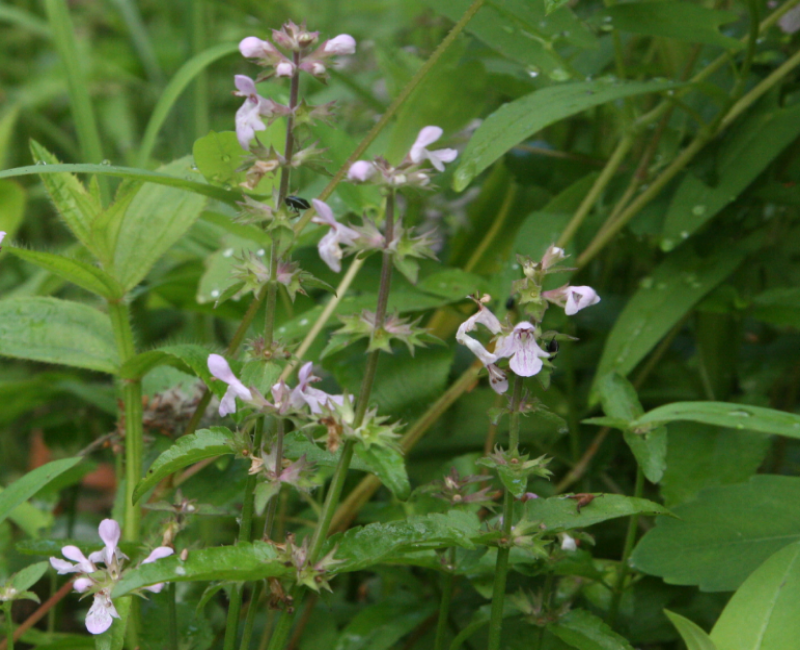
- Local Name: Florida Betony, Florida Edgenettle, or Rattlesnake Weed
- Family: Lamiceae
- Annual or Perennial: Perennial
Florida Betony is a native weed that emerges between September and October in North Florida and between November and December in Central and South Florida.
The cool-season weed is erect, with square stems, serrated leaves, and clusters of pink and white flowers with purple spots. It is highly adaptable (it can thrive in two extreme conditions, like full sun or shade) and can be found in various habitats, including gardens, lawns, planting beds, and fields.
The weed develops numerous tubers and rhizomes, making it difficult to control. Hand pulling and digging out the root systems can be effective for small infestations.
For larger areas, consider a systemic postemergence herbicide like glyphosate, as it will kill the plant down to the tubers and rhizomes.
11. Matchweed (Phyla nodiflora)
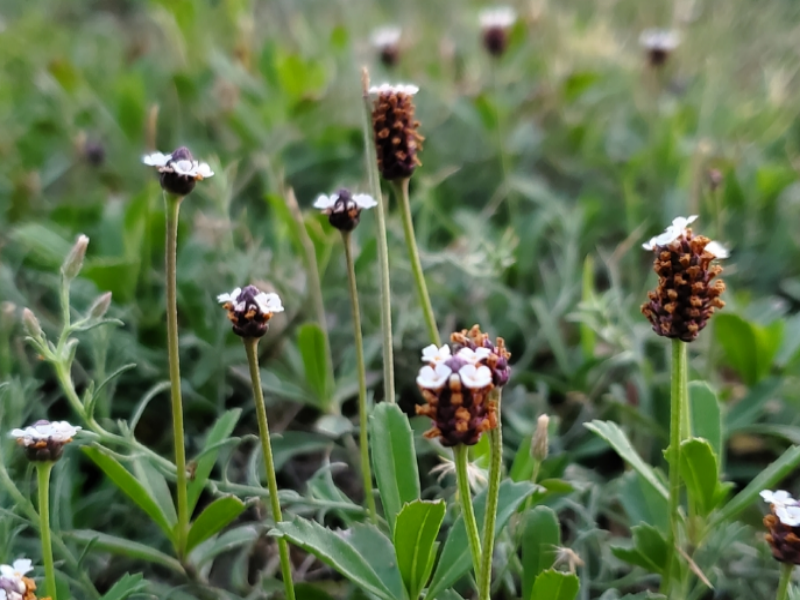
- Local Name: Matchweed, Texas Frogfruit, Turkey Tangle Fruit, Capeweed
- Family: Verbenaceae
- Annual or Perennial: Perennial
Matchweed is a native perennial that is considered both a weed and a good groundcover in Florida.
It produces prostrate, branched stems, 1-inch-long leaves with toothed margins near the apex, and white to pink pollinator flowers.
Where lawns are preferred, it is considered a weed. It spreads by seeds and stolons, forming dense mats and overtaking large areas. Where soils and environmental conditions may not be conducive for lawn maintenance, Matchweed is considered a groundcover alternative.
If it becomes weedy, hand-pulling or applying a postemergence herbicide like atrazine, depending on your turfgrass type can help eradicate the weed.
12. Purple Thistle (Cirsium horridulum)
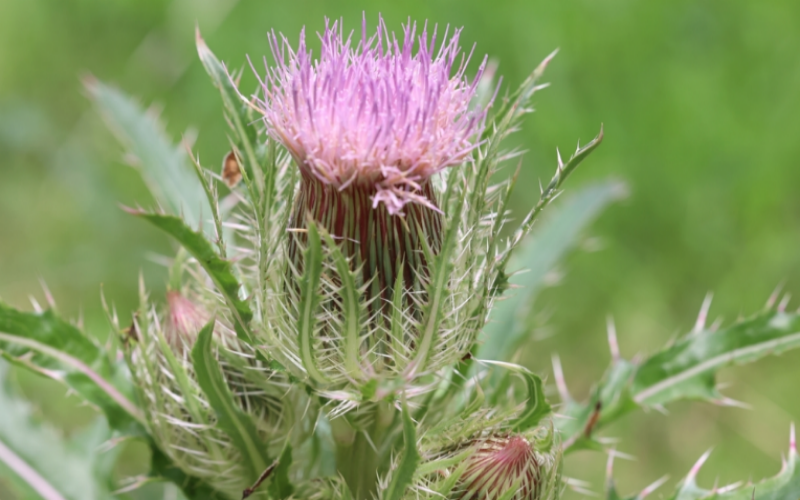
- Local Name: Purple Thistle
- Family: Asteraceae
- Annual or Perennial: Biennial
Purple Thistle is among the most common thistles found throughout Florida. You can identify it by its abundant spines on every part of the plant, including the basal rosette leaves, stems, and the compact purple brushheads surrounded by spiny leaves.
The weed occurs naturally along roads, prairies, pinelands, pastures, and other disturbed sites. It is a prolific seed producer that also spreads through underground suckers, making it difficult to control.
Well-timed mowing after the rosettes bolt but before they flower can control the thistle spread. For long-term control, consider applying herbicides like dicamba, 2,4-D, or glyphosate on the Purple Thistle rosettes.

Lead Editor for Insight Weeds.